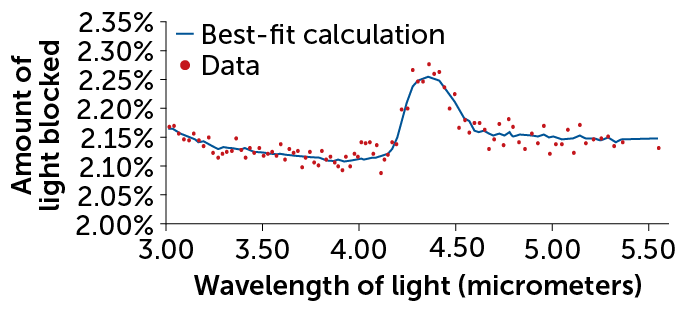The James Webb Space Telescope has gotten the first sniff of carbon dioxide in the atmosphere of a planet in another solar system.
“It’s incontrovertible. It’s there. It’s definitely there,” says planetary scientist and study coauthor Peter Gao of the Carnegie Institution for Science in Washington, D.C. “There have been hints of carbon dioxide in previous observations, but never confirmed to such an extent.”
The finding, submitted to arXiv.org on August 24, marks the first detailed scientific result published from the new telescope. It also points the way to finding the same greenhouse gas in the atmospheres of smaller, rockier planets that are more like Earth.

Sign Up For the Latest from Science News
Headlines and summaries of the latest Science News articles, delivered to your inbox
Client key* E-mail Address* Go
Thank you for signing up!
There was a problem signing you up.
The planet, dubbed WASP-39b, is huge and puffy. It’s a bit wider than Jupiter and about as massive as Saturn. And it orbits its star every four Earth days, making it scorching hot. Those features make it a terrible place to search for evidence of extraterrestrial life (SN: 4/19/16). But that combination of puffy atmosphere and frequent passes in front of its star makes it easy to observe, a perfect planet to put the new telescope through its paces.
James Webb, or JWST, launched in December 2021 and released its first images in July 2022 (SN: 7/11/22). For about eight hours in July, the telescope observed starlight that filtered through the planet’s thick atmosphere as the planet crossed between its star and JWST. As it did, molecules of carbon dioxide in the atmosphere absorbed specific wavelengths of that starlight.
Previous observations of WASP-39b with NASA’s now-defunct Spitzer Space Telescope had detected just a whiff of absorption at that same wavelength. But it wasn’t enough to convince astronomers that carbon dioxide was really there.
“I would not have bet more than a beer, at most a six pack, on that weird tentative hint of carbon dioxide from Spitzer,” says astronomer Nicolas Cowan of McGill University in Montreal, who was not involved with the new study. The JWST detection, on the other hand, “is rock solid,” he says. “I wouldn’t bet my firstborn because I love him too much. But I would bet a nice vacation.”
The JWST data also showed an extra bit of absorption at wavelengths close to those absorbed by carbon dioxide. “It’s a mystery molecule,” says astronomer Natalie Batalha of the University of California, Santa Cruz, who led the team behind the observation. “We have several suspects that we are interrogating.”
Carbon dioxide bump
The spectrum of light that filtered through the atmosphere of exoplanet WASP-39 b shows strong evidence for containing carbon dioxide. The large bump in the middle of the spectrum shows that the planet’s atmosphere absorbed light with wavelengths around 4.3 micrometers — a clear sign of CO2. A smaller bump (shown as three dots above the best-fit line) to the left of the CO2, around 4 micrometers, could represent a mystery molecule.
A spectrum of exoplanet WASP-39b’s atmosphere NASA, ESA, CSA, Leah Hustak and Joseph Olmsted/STScINASA, ESA, CSA, Leah Hustak and Joseph Olmsted/STScI
NASA, ESA, CSA, Leah Hustak and Joseph Olmsted/STScINASA, ESA, CSA, Leah Hustak and Joseph Olmsted/STScI
The amount of carbon dioxide in an exoplanet’s atmosphere can reveal details about how the planet formed (SN: 5/11/18). If the planet was bombarded with asteroids, that could have brought in more carbon and enriched the atmosphere with carbon dioxide. If radiation from the star stripped away some of the planet atmosphere’s lighter elements, that could make it appear richer in carbon dioxide too.
Despite needing a telescope as powerful as JWST to detect it, carbon dioxide might be in atmospheres all over the galaxy, hiding in plain sight. “Carbon dioxide is one of the few molecules that is present in the atmospheres of all solar system planets that have atmospheres,” Batalha says. “It’s your front-line molecule.”
Eventually, astronomers hope to use JWST to find carbon dioxide and other molecules in the atmospheres of small rocky planets, like the ones orbiting the star TRAPPIST-1 (SN: 12/13/17). Some of those planets, at just the right distances from their star to sustain liquid water, might be good places to look for signs of life. It’s yet to be seen whether JWST will detect those signs of life, but it will be able to detect carbon dioxide.
“My first thought when I saw these data was, ‘Wow, this is gonna work,’” Batalha says.

